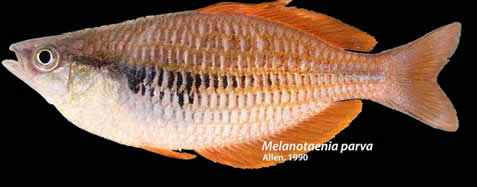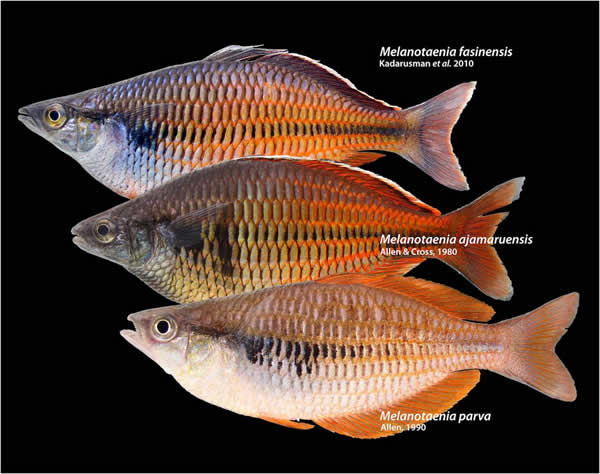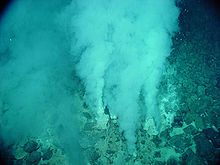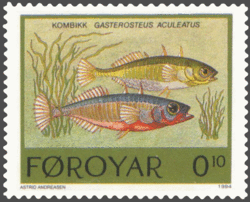Tag Archives: Fish
Extinction Looms Near For Rainbowfish as Lake Dries Up!
A rather magnificent specimen of rainbowfish, prized and coveted for aquarium owners around the globe, is staring into the abyss, and could possibly face extinction since their home is drying up, and alien fish seem to be moving in.
The rainbowfish, Melanotaenia parva, was was described by accomplished ichthyologist Dr. Gerald Allen back in 1990. These magnificent rainbowfish hail from Kuromoi Lake on the Bird’s Head Peninsula in West Papua, Indonesia.
At the time of their discovery, the rainbow fish were abundant, however the water seemed to be receding. The level of the water of the lake had already reached levels lower than the outlet with the Yakati River, however more unsettling was the discovery that a non-native Tilapia had made its way on to the scene. Now, researchers have commenced a new study and have found some good news, and bad news.. Good news, a bright colorful new species of rainbow fish.. Bad news.. Lake Kuromi, where these rainbow fish call home, is almost completely dry.
Now a new study by scientists who have just described a new species of rainbowfish from the Bird’s Head Peninsula have shown that its home – Lake Kuromoi – is now almost completely dry.
These startling discoveries were made back in June 2007, but have only now made their way to the public eye. To top it all off, as if having your home dry out wasn’t bad enough, the rainbowfish now need to compete for survival with a rogue species of Tilapia.
What is to become of these poor rainbowfish?
Melanotaenia fasinensis – New Rainbow Fish Named From West Papua
Researchers have just discovered and described a new rainbow fish which hails from West Papua, Indonesia.
Ichthyologists, also known as fish scientists to us normal folk, Paradis, Pouyaud, Kadarusman and Sudarto are credited with the find and have dubbed the new kind of rainbow fish Melanotaenia fasinensis. They published this in a paper in the journal Cybium.
The new rainbow fish was found in the Fasin River, just about 25 clicks west of Lake Ayamaru on the West Papua’s Bird’s Head Peninsula.
The little guy was found floating about in a 1 meter deep, 4.5 meter wide stream, surrounded by flush greenery.
This rainbow fish lives over a substrate of gravel, and makes its home amongst limestone boulders and debris of fallen branches from the forest.
The Fasin River also boasts a myriad of other species such as sleeper gobies, and different types of crayfish.
The Bird’s Head Peninsula in Indonesia is considered a hotspot when one is going about and trying to find rainbow fish. There are many different kinds of rainbow fish which also call the place home, and they all seem to live in harmony with one another.
It’s good to see that the scientific world has not given up on seeking new kinds of this beautiful fish. Not only are they pretty to look at, but they are key to the survival of all the species in that ecosystem.
Some people have been trying to catch them and sell them off as pets, however an ordinance is in place telling people to refrain from such a practice.
Largest Destroyer Sunk To Become Part of Artificial Reef off the Coast of N.J.
The U.S. Navy Destroyer Arthur W. Radford, a massive 563 footer, is due to be sunk 30 miles from the shore of Cape May County next month. This is the largest ship thus far which has been sunk to become part of an artificial reef system.
It is expected that this ship will become the star of the show, and attract many inquisitive scuba divers and fishermen at the Deljerseyland Reef. The reef is the brainchild of New Jersey, Delaware and Maryland to help not only help the environment, but to also promote tourism in the area. Rather than sell the hulk off for scrap, they instead raised the estimated value of $800,000 from private parties interested in supporting the project, and will be trying to do some good with it. The $800,000 raised is being split by the three states, whom will all benefit from the artificial reef project.
Some question the logic behind doing such a project, however it is a very good move, both economically and politically. The green groups will be happy, as it is helping out the environment, and the tax payers will be happy, as the added tourism and influx of funds generated by the reef, should help to ease the drain on their wallets.
The destroyer is currently sitting at the Philadelphia shipyard and awaiting the torpedoes which will place it into its new watery home at the bottom of the sea.
Whole Foods to Stop Selling Over-Fished Species In Time For Earth Day 2013

Green means “go ahead and shop till you drop”, yellow means “Caution. some concerns are being raised with the species”, and red means “you really shouldn’t be buying this product at all”.
They are aiming to phase out all products which are classified as “red”, which means that they are highly over fished and at risk, by Earth Day in the year 2013.
They have partnered up with Monterey Bay Aquarium and Blue Ocean Institute to help them categorize their products. Whole Foods is the first such national grocer which will have such a system in place, and it is causing waves throughout the industry.
Both Monterey Bay Aquarium and Blue Ocean Institute are well known and respected for their science-based seafood programs. They painstakingly evaluate species and the fisheries which reel them in, and categorize them based on life history, abundance, habitat impacts, fishery management practices and bycatch.
It’s good to see big business finally taking an interest in keeping the Earth and its oceans in prime condition, and not just worrying about their bottom line.
Research Proves that Flying Fish are More Effective at Gliding Than Insects, And Just As Efficient as Birds
We all know about those birds which are just at home in the water as they are in the air, however, not too many species of fish can say the same thing. Flying fish can actually stay up in the air for more than half a minute, and can glide as far as 400 meters and reach speeds of up to 70 kilometers per hour!
A mechanical engineer from Seoul National University in Korea, Haecheon Choi, took a shine to the flying fish as he was reading a science book to his children. By coming to the realization that flying fish actually FLY, he and his collegue, Hyungmin Park, set about to figure out just how these fish stay up in the air so long and then publish their discovery in The Journal of Experimental Biology, which they did this past 10th of September. They had some remarkable results in tsts conducted in a wind tunnel of all places.. They found that the flying fish were just as efficient at gliding as birds were, and more effective than many forms of insects at it.
Now that Choi and Park have proven to the world that flying fish are exceptional fliers, they are now setting up for their next big task.. Building an aircraft which will exploit the ground effect aerodynamics which flying fish use to their benefit.
Breaking News: New Snail Larval Form discovered: First since 1978!
Well, just when you are comfortable knowing that what you know is accurate, the world comes along and throws you another curve ball. We used to know there were 9 planets, now there are 8, we used to know the earth was the center of the solar system, now we know better.. Now, just when you thought you pretty much knew your basic zoology, an amazing new discovery has been made that is basically going to force some poor guy to rewrite the molluscan, larval ecology and invertebrate text books.
Between the 1850’s and the 1870’s supposedly all known forms of snail were discovered. However, thanks to modern technology, and some persistent researchers, we now know that we were mistaken, and that the forms of snail are really much more diverse than originally thought.
This new snail larval form is really turning heads, and here’s why. This larval form discovered is the first of its kind to be found to be a free-swimming pre-veliger larva. This is rather interesting because normally they don’t swim freely. Not only that but it appears these new little guys can actually turn hydrogen sulfide, and methane as an energy source.. Imagine, a snail which subsists on farts…
Credited with this astounding discovery are Anders Waren, a Swedish Naturalist from the Royal Museum of Natural History in Stockholm, and collegue Philippe Bouchet.
They have been working on this project since the 1980s, and have finally made their marks on history. These are a pair to watch folks, who knows what they might discover next?
Male Fish Won’t “Ask For Directions”
Recent research has come to the astonishing conclusion that fish, specifically the males, positively refuse to ask for directions when they are breeding.
A recent research project, by the University of St. Andrews, has found that male fish seem to become more anti-social feeders, becoming even more so when they are ready to spawn.
As a result of this, they put themselves in greater peril, by leaving the shoal behind.
The claim is being made by researchers in charge of the project that this is one of the first studies performed that has shown a differences in the sexes when it comes to how animals learn from one another.
The current belief is that this trait is only seen in male fish when they are getting ready to spawn or are spawning, and may correlate to the distinct pressures faced by the sexes when spawning.
The research was conducted by Dr. Mike Webster and Professor Kevin Laland, whose goal was to take a look at the copying and learning behaviors of ninespine stickleback.
It appears the males tend to look for food reserves on their own, so that they can properly protect their young when the time comes, and this is why they don’t feed together.
Dr Webster added: “We are all familiar with the stereotype of males refusing to ask for directions – this might apply to fish too, but only when they are preparing to breed.”
New Species of Filament Barb Named After Ichthyologist
A brand new kind of filament barb has been discovered and described which is from India’s southern tip. This new discovery was released in the newest edition of the Journal of Threatened Taxa. This is really quite an astonishing discovery, and it leads one to wonder what other marvels may be hiding themselves away in the depths of the sea, far from the prying hands of us humans.
Authors, TJ Indra, K Rema, and JD Marcus Knight have dubbed the new barb discovered Puntius rohani, after Rohan Pethiyagoda, an accomplished Ichthyologist, for his contributions on both Sri Lankan and Indian fish.
This new filament barb is distinguished by others of its species by the fact that this particular barb has a black club-shaped blotch by the caudal peduncle. It also seems to lack any other colors or patterns other than this blotch, and it also doesn’t have the black bands near the tip of its caudal fin lobes.
The actual report is really quite riveting, and tells a great deal more about the new filament barb, other differences, discovery, and notations.
If you would like to hear more on this subject, you will need to refer to the paper itself: Devi, KR, TJ Indra and JDM Knight (2010) Puntius rohani (Teleostei: Cyprinidae), a new species of barb in the Puntius filamentosus group from the southern Western Ghats of India. Journal of Threatened Taxa 2(9): 1121-1129. Read the papper (pdf)
World Record Tilapia Reeled in St. Lucie River
The black depths of the St. Lucie River’s South Fork have really been making waves, and provided quite a catch for an angler.
This past Tuesday evening, Pamela Henry was having a nice quiet time fishing from her dock on the waterway. As she was lazily tossing balls of dough into the water, some of which had peanut butter, she gazed upon a myriad of different kinds of fish which fought over them. However, after repeatedly seeing the mouth of a big “snapper-like looking fish,” Henry thought it was high time to grab a pole and try her luck.
“I just grabbed the first rod I could find and it ended up being one of my old spinning outfits,” commented Henry. “It had 20-pound test line and no leader, but I was going to catch that fish.”
Henry opted to use a soft dough ball for the bait – as she explained that the fish don’t like hard balls- and cast her line into the water, complete with a bobber made of styrofoam.
Reeling in Tilapia with a rod is not an easy thing to accomplish, Henry explained. First of all, they are vegetarians, but secondly, there is something off about the way they feed.
“You have to be patient with a tilapia. They suck in the bait, then spit it out again before they really eat it,” she went on to explain.
Well all her patience paid off, as she reeled in a whopper of a Tilapia, weighing in at 9 pounds, 6 ounces. By all accounts it’s a record breaker.. Congratulation Pamela!
Rare “Ribbon Fish” Fish Makes Way to Aquarium
An interesting “ribbon” fish has made its way to an aquarium, after being reeled in accidentally by fisherman.
The fish was identified as a red bandfish by officials at the aquarium.
The fish, found on the south coast, has been donated to the Blue Reef Aquarium in Portsmouth, Hampshire.
However, this fish, which can grow to a length of 32 inches, can be reeled in as far south as Senegal on the west coast of Africa, and in the Mediterranean.
Lindsay Holloway, of the Blue Reef, commented: “They’re extraordinary-looking fish that definitely seem to be more at home in the Mediterranean than around our shores.”
“No one is sure how many there are living in the Channel as they are normally very shy and reclusive fish who spend the majority of their lives inside their burrows.”
“One reason that this individual was caught may be as a result of the recent stormy weather, which can result in their burrows being destroyed.”
“As a result, dead specimens are sometimes washed up on to the strandline after rough seas.”
Living up to its name, the fish is usually red, with orange and yellow highlights, making it look like a ribbon. It also sports silver colored eyes, and very tiny, but razor sharp, teeth.
Like many other tropical garden eels, the red bandfish are believed to spend most of their days hidden from view, in their tiny caves located on the seabed some 1,300 feet deep, and only emerge at night.










